You only need 30 minutes to make this Quick Tomato Sauce recipe with strained tomatoes or Passata di Pomodoro. Then, combine it with your favorite pasta for an easy pasta dinner.
There are endless variations of sauces using tomatoes.
Throughout the summer, this roasted tomato sauce is one of my favorite recipes to make using my garden fresh cherry tomatoes.
When I need a sauce for my homemade pizza dough, I use my mom’s no-cook pizza sauce recipe.
This simple and quick marinara sauce is best to make with whole canned San Marzano tomatoes.
Today, I’m sharing yet another quick and easy pasta sauce recipe great with ricotta cavatelli, or to use when making eggplant parmesan, stuffed pasta shells or even lasagna. It is made with uncooked pureed and strained tomatoes aka passata usually sold in glass containers.
When I need a smooth and more refined tomato sauce, I use tomato passata as a base and build the flavors. It’s great to use with baked pasta dishes like lasagna rolls or cannelloni.
It’s also a great sauce for a fast weeknight pasta dinner like this easy tortellini recipe. Set the water to boil, cook the pasta, and make this fast sauce while that is going on. Supper is served in under 30 minutes.
Great tasting and so versatile!
What matters the most when making this quick and easy tomato sauce recipe with so few ingredients is the quality of the ingredients.
Use the best ingredients and your tomato sauce will taste great.
Here is what we need.
Ingredients
A printable recipe card found at the bottom of this page has the specific amounts for each ingredient. This is just a summary.
- Olive oil. Use a good quality olive oil.
- Garlic. It provides loads of flavor.
- Sweet Onions: Another flavor enhancer.
- Passata di Pomodoro. Strained tomatoes, preferably San Marzano; commercial or homemade.
- Parsley. Fresh, Italian flat-leaf.
- Basil. Once again use fresh and add at the end of the simmering process.
Instructions
Let’s prep some of the ingredients for this simple tomato sauce.
Chop 2-3 garlic cloves and mince 1 medium sweet onion. We also need to roughly chop the equivalence of 2 tablespoons of Italian flat-leaf parsley.
Heat 4 tablespoons of olive oil in a heavy-bottomed wide saucepan over medium-high heat.
Reduce the heat to medium. Add the chopped garlic and sauté for 30 seconds or so.
Add the minced onions and continue to sauté for 5-7 minutes until translucent. Stir occasionally. The addition of a pinch of red pepper flakes at this point is optional.
Add 2 (24 ounces) jars of tomato passata and watch for some splattering! Add 1 cup of water in each jar, swirl, and add the liquid back to the saucepan. We don’t want to waste one drop of the passata.
Increase the heat to medium-high and bring to a simmer. At this point, taste your tomato sauce. Adjust for salt and pepper. If the passata is of high quality, the tomatoes should not taste acidic. If there is an acidic aftertaste, add a few carrots, sliced in half. This sometimes works to take the edge off the sauce.
Reduce the heat to medium, cover the sauce, and allow to cook for 20-30 minutes. Stir occasionally.
When the sauce has finished simmering, taste and adjust for seasonings. If the sauce still tastes acidic, try adding a pinch of baking soda or a pinch of sugar. Once again taste and adjust.
A good friend of mine, who happens to be a professional chef told me that one of the first chef’s secrets that he learned was to use a few tablespoons of a sweet carbonated drink to take the edge off of an acidic sauce.
Isn’t that interesting?
Add 2 tablespoons of chopped fresh Italian parsley as well as 3-4 leaves of fresh basil.
It can be used immediately with any recipe or allow to cool down, refrigerate, and use within the next 5-7 days.
Tips
- Use the best quality and freshest ingredients. Taste the tomatoes before you start cooking them.
- Always taste your sauce so that you can make early adjustments for acidity and bitterness.
- Add the fresh herbs at the end as they can become bitter if added at the beginning of the cooking process.
What should I look for in a quality passata?
- As a general rule, if the tomatoes are in a glass bottle, this avoids that « metallic » aftertaste.
- If the tomatoes are of high quality, picked at the height of the season, you will smell the sweetness of the tomatoes as soon as you open the jar.
- Look at the list of ingredients… ideally, there should tomatoes and a little bit of salt. That’s it. If the ingredients include anything else, for example, citric acid, or herbs, it may be an indicator of an inferior product.
- Italy is well known for its tomatoes. If you would like to know more about their certification process, there is a great article on Serious Eats about the DOP tomato. (DOP is short for Denominazione di Origine Protetta)
My suggestion is to try different high-quality brands and compare… but it depends on the quality of the tomatoes when they were picked.
How to Prevent a Bitter tasting Tomato Sauce:
- Start with high-quality tomatoes which are naturally sweet. If you start with sub-par tomatoes, the result tastes sub-par.
- When sauteing the garlic, do not burn it as burnt garlic tastes bitter.
- Most herbs become bitter with a long-simmering process, always add them at the end.
- Make sure to properly salt throughout the whole process of making the sauce.
- The addition of a whole carrot, potato, or even an onion contributes a little bit of natural sweetness to the sauce.
- Add one or two cloves of roasted garlic.
- A couple of tablespoons of Port might take a bit of the edge off.
- As a last resort, try adding a pinch or two of brown sugar as the sauce simmers.
How to make a tomato sauce less acidic
Tomatoes are considered to be acidic. That being said, start with a product that uses high-quality tomatoes. Also:
- At the end of the cooking time, add a few pinches of baking soda. You will notice that there will be foam. Keep stirring until the foam disappears. Baking soda neutralizes the acidity of the tomatoes.
- Add a pat of butter at the end of the simmering process. This sometimes evens out the flavors.
How to store
If using within the next 5-7 days, allow the sauce to cool down to room temperature. Then, refrigerate and store in glass mason jars.
How to freeze
Allow the sauce to cool down to room temperature then transfer to freezable containers of bags. It can be frozen for up to 3 months.
Recipe origins
As you can well imagine, growing up Italian meant that at the end of every summer, my family would can whole tomatoes as well as make tomato passata from bushels of freshly picked San Marzano and Roma tomatoes.
My mom and dad would drive out to a local farm and handpick about 15 bushels of tomatoes.
Believe me, when I tell you, that was a lot of tomatoes!
I love this family tradition of preserving local tomatoes. The process of documenting and creating a step-by-step procedure on how to make tomato passata is well underway. I will eventually share this family tradition with all of you.
My mom would often make this quick and simple sauce when she would make baked pasta recipes.
Moms do know best!
I hope you are all having a great day!
THANKS SO MUCH for following and being part of the She Loves Biscotti community where you will find Simple & Tasty Family-Friendly Recipes with an Italian Twist.
Ciao for now,
Maria
★★★★★ If you have made this Simple Pasta Sauce, I would love to hear about it in the comments below and be sure to rate the recipe!
Recipe
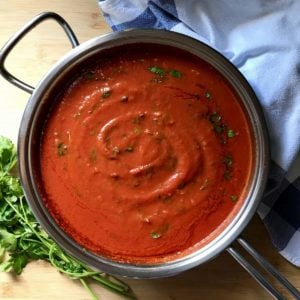
Quick Tomato Sauce
Ingredients
- 4 tablespooons olive oil extra virgin
- 2-3 cloves garlic chopped
- 1 medium onion sweet, minced
- pinch red pepper flakes optional
- 48 ounces passata 2 x 24 ounces jars of strained tomatoes
- 2 cups water
- 2 tablespoons parsley Italian flat leaf, chopped
- 3-4 basil leaves fresh
Instructions
- Heat the olive oil in a heavy-bottomed saucepan over medium-high heat.
- Reduce the heat to medium. Add the chopped garlic and sauté for 30 seconds or so.
- Add the minced sweet onions and continue to sauté for 5-7 minutes until translucent. Stir occasionally. The addition of a pinch of red pepper flakes at this point is optional.
- Add the 2 jars of tomato passata and watch for some splattering! Add 1 cup of water in each jar, swirl and add the liquid back to the saucepan.
- Increase the heat to medium-high and bring to a simmer. At this point, taste your tomato sauce. Adjust for salt and pepper. If the passata is of high quality, the tomatoes should not taste acidic. If there is an acidic aftertaste, add a few carrots, sliced in half. This sometimes works to take the edge off the sauce.
- Reduce the heat to medium, cover the sauce and allow to simmer for 20-30 minutes. Stir occasionally.
- When the sauce has finished simmering, taste and adjust for seasonings. If the sauce still tastes acidic, try adding a pinch of baking soda or a pinch of sugar. Once again taste and adjust.
- Add 2 tablespoons of chopped fresh Italian Parsley as well as 3-4 leaves of fresh basil.
- It can be used immediately with any recipe or allow to cool down, refrigerate and use within the next 5-7 days. It can also be frozen for up to 3 months.
Notes
- Depending on the total simmering time, total yield is approximately 7 cups.
- Use the best quality and freshest ingredients.
- Always taste your sauce so that you can make early adjustments if your sauce is acidic.
- Add the fresh herbs at the end as they can become bitter if added at the beginning of the cooking process.



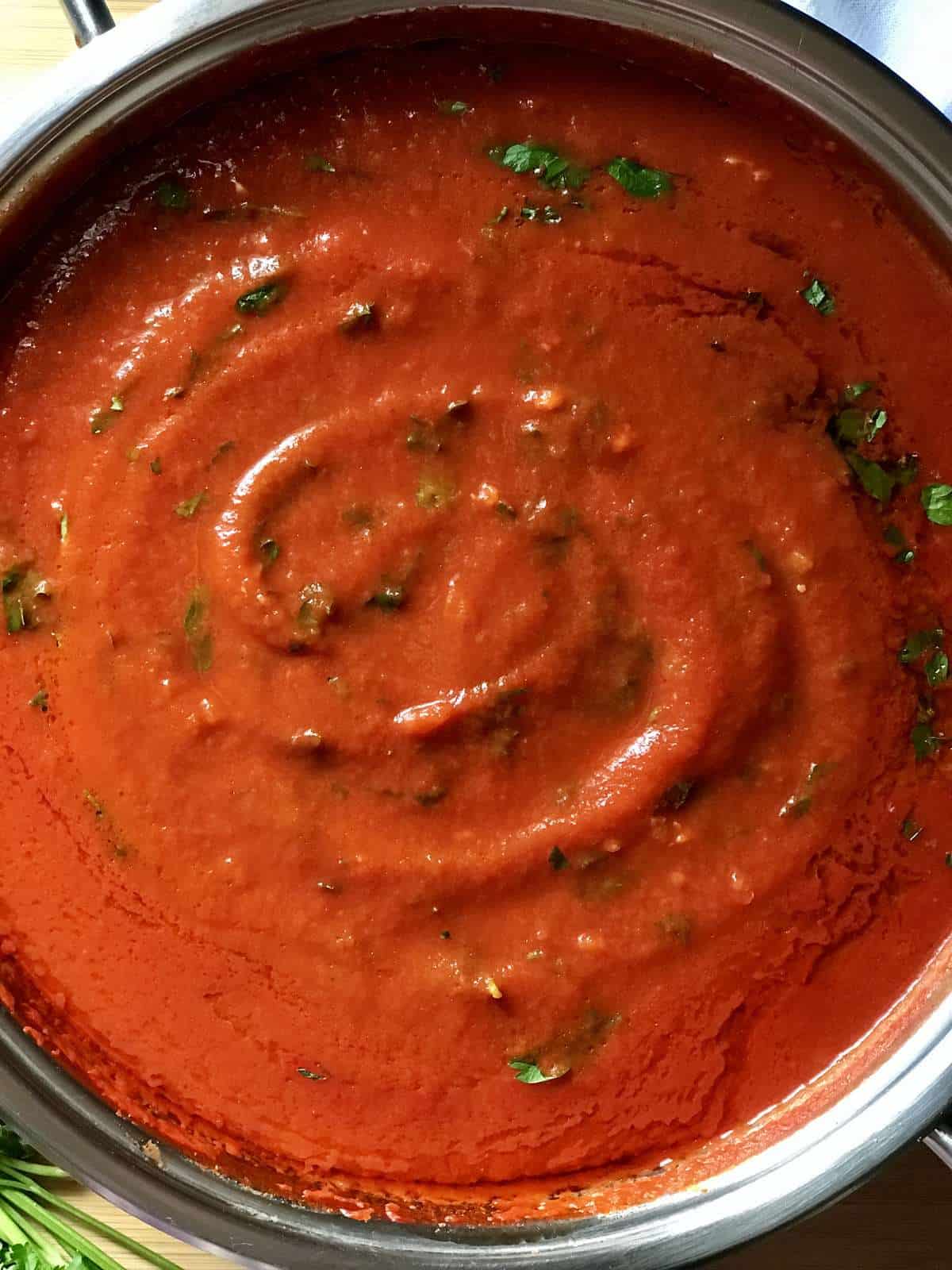
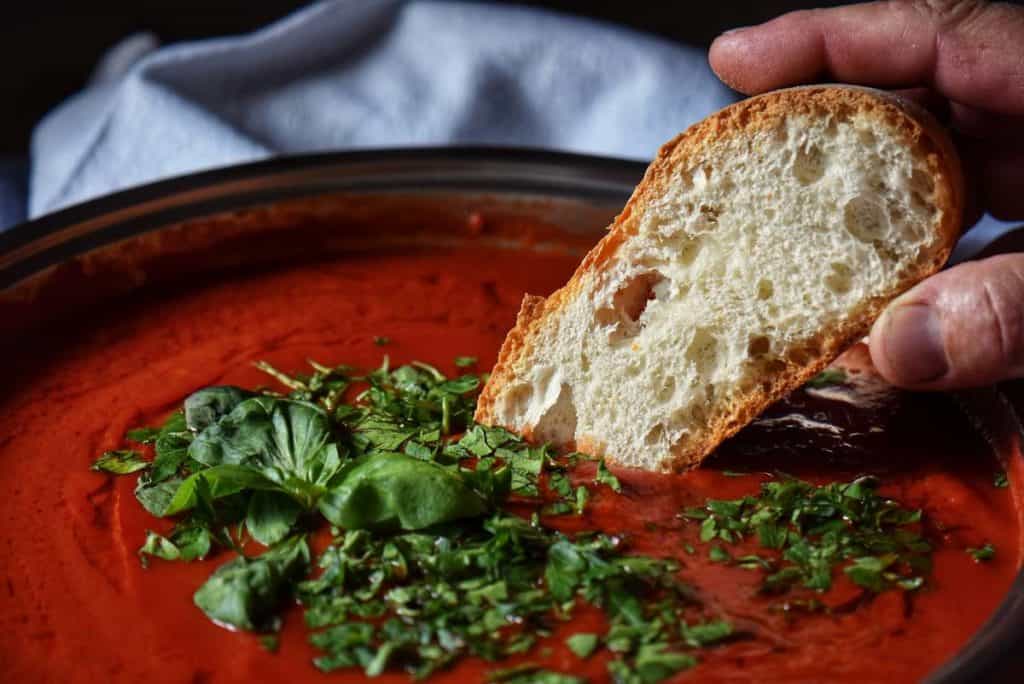
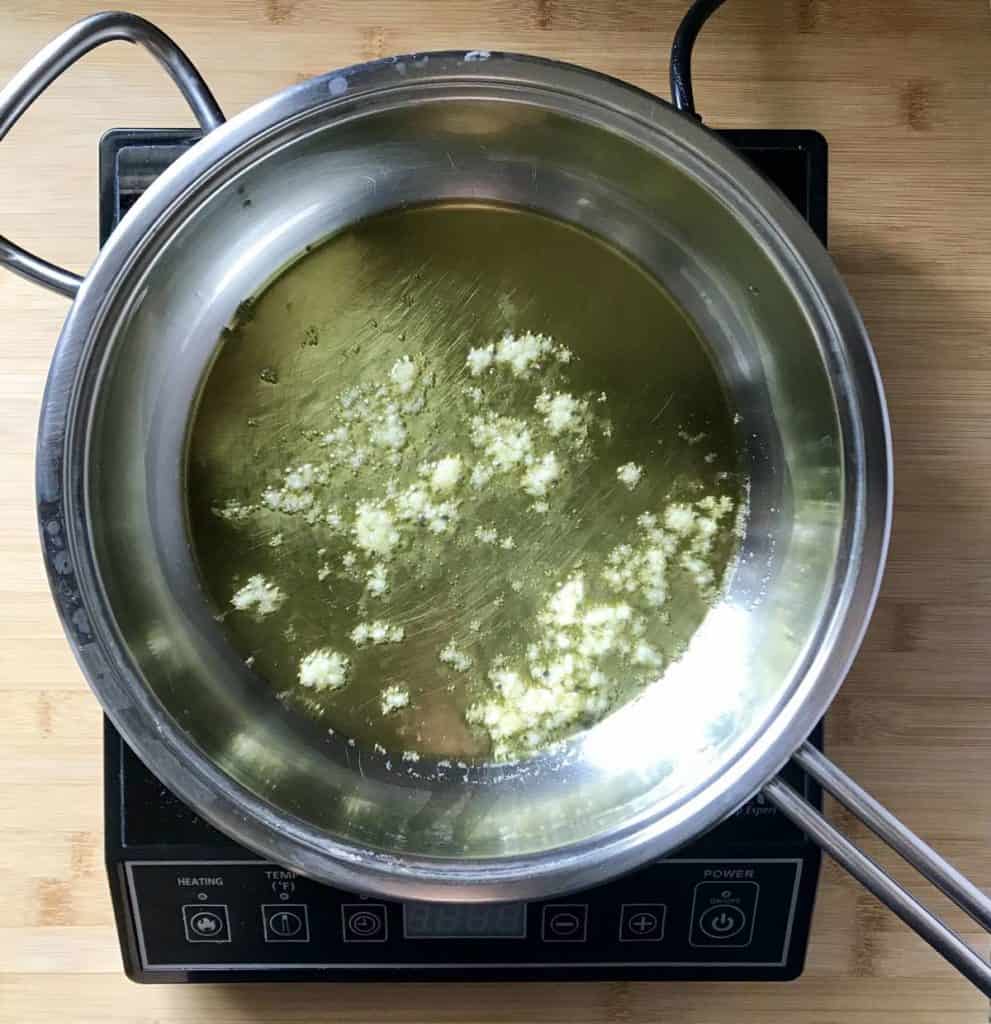
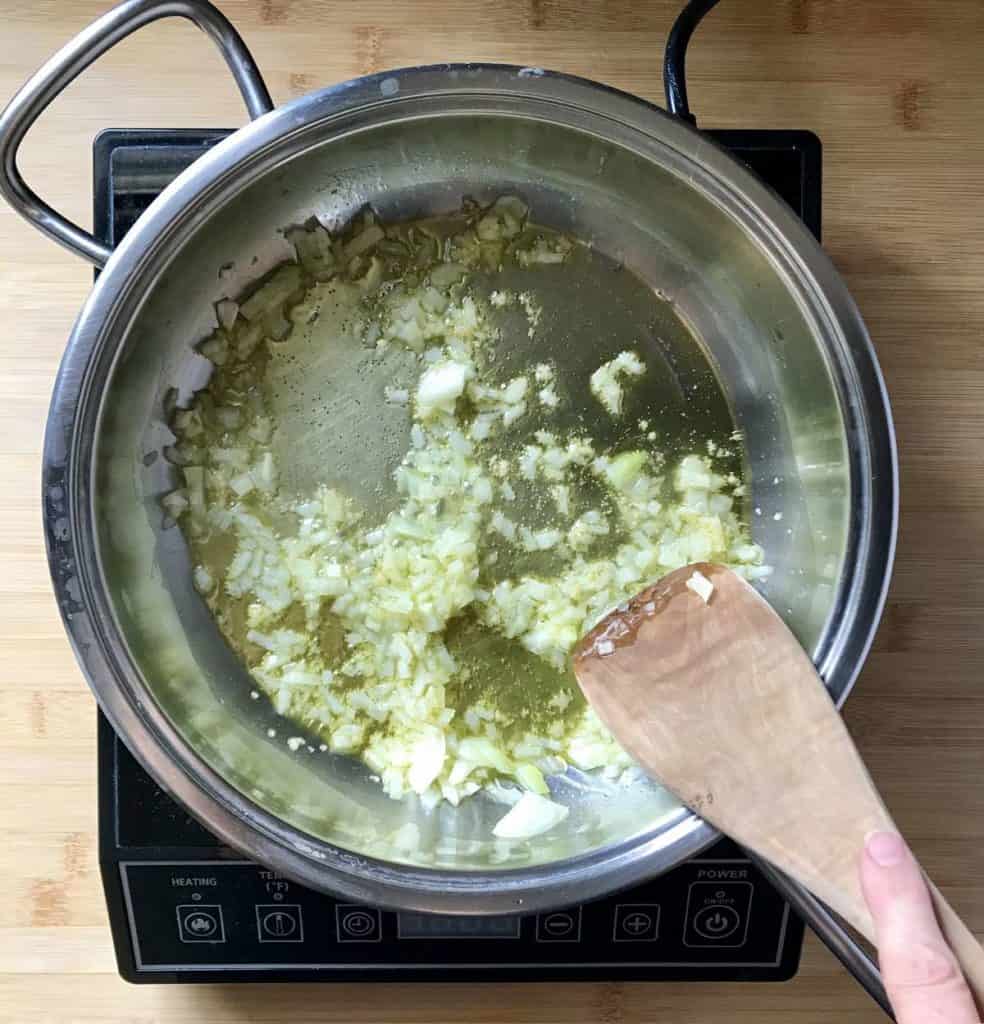
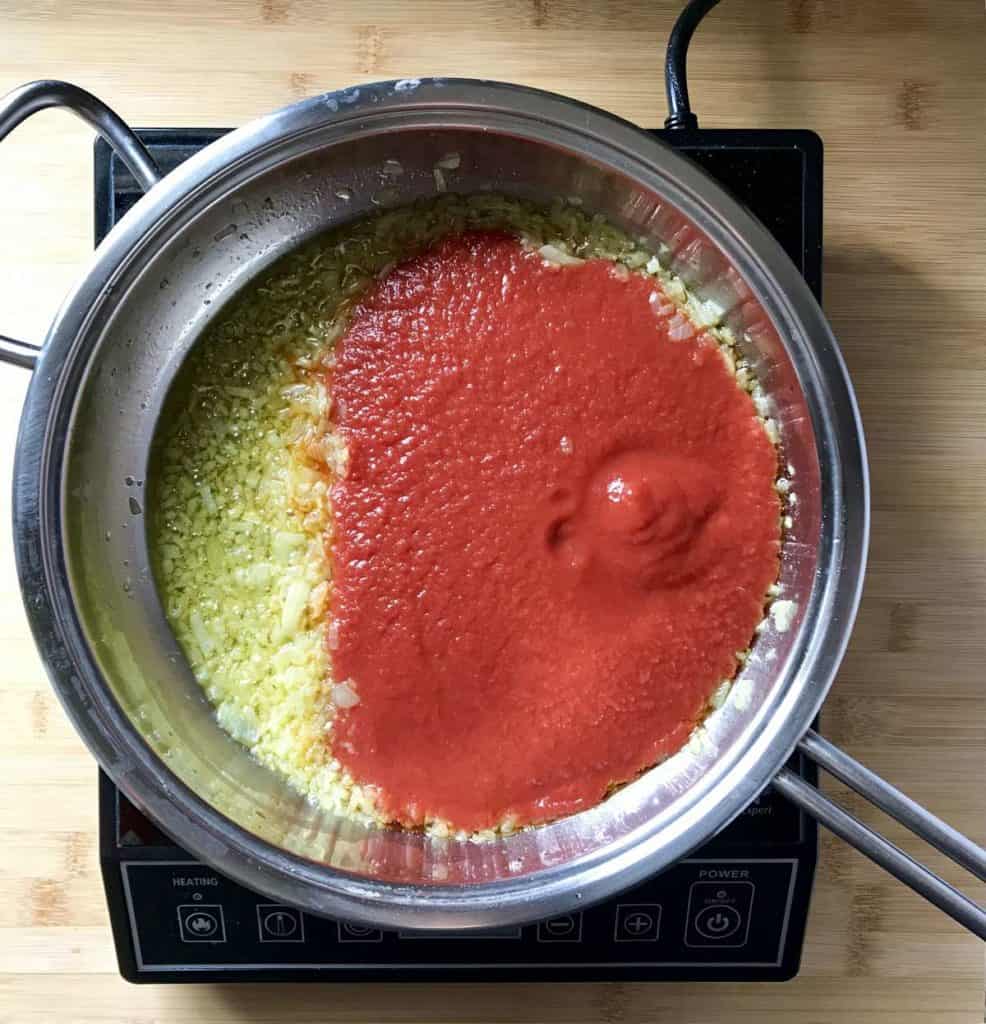
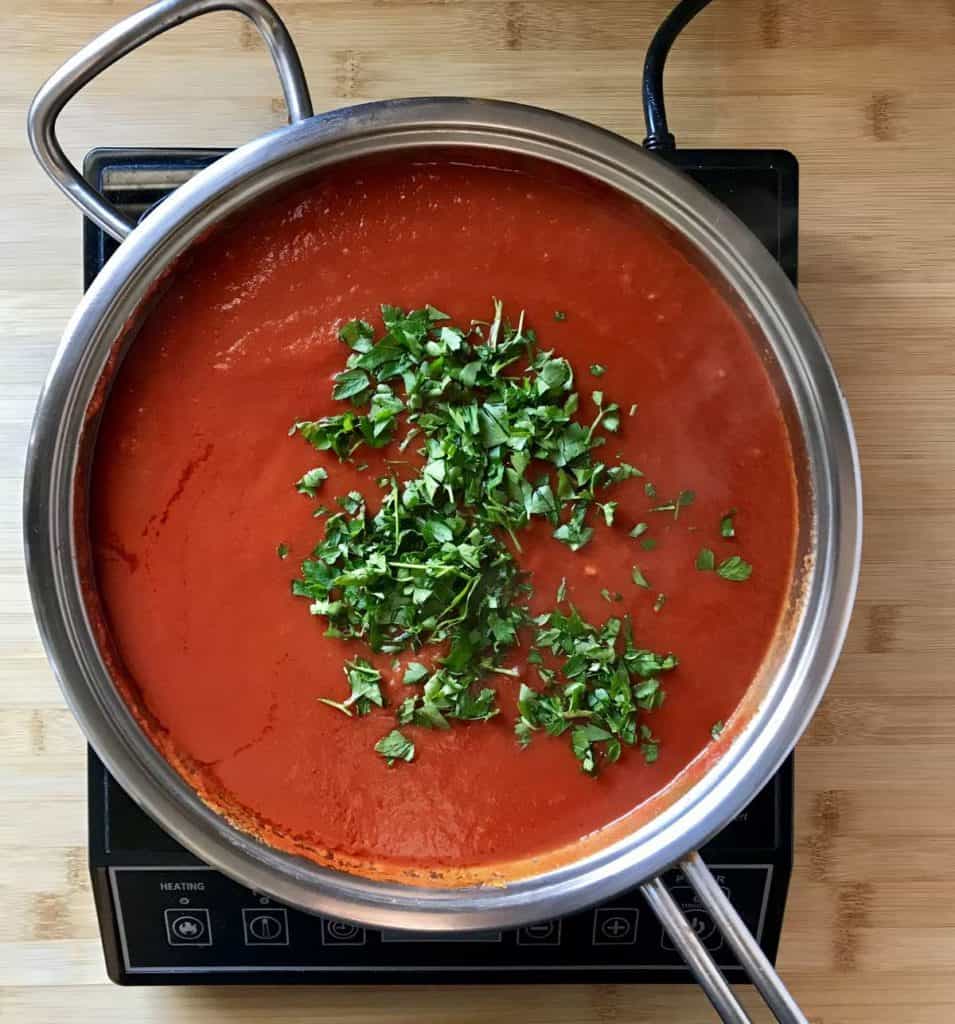
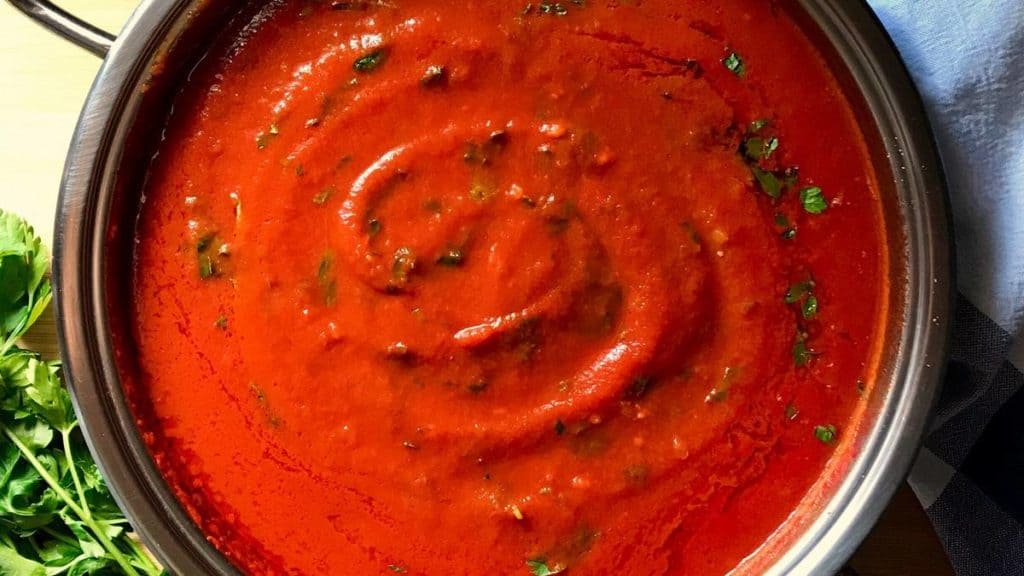
Cara Roxanne
This was such a well written recipe – you offered reasons behind the ingredients, such as good quality passata, as well as suggestions for troubleshooting issues like bitterness and acidity.
I had one jar of beautiful passata and one large can of Cento crushed tomatoes and managed to turn it into a beautifully balanced sauce – I added 2 halved carrots as it simmered, and some brown sugar when it was still a bit too acidic and now it is perfect. Thank you!
Maria
Thanks so much for sharing Cara!
Erez
Having just returned from Italy, I had spent over an hour looking for just the right tomato sauce recipe, one that would remind me of those authentic Italian restaurants. I thought it couldn’t be simpler, and yet no two recipes were alike! Despite coming across dozens of recipes, this one stood out immediately.
Without any bells and whistles, you humbly walk us through your method, and spare no explanation as to why we do what we do. With so little ingredients, one would expect other recipe writers to touch on how to tell good ingredients from lesser good ones, but none did. Thanks for that, Maria!
As I like to experiment, I have made some modifications that I’d like to share. I used a red onion for sweetness, color, and for its milder flavor. I also added a teeny tiny bit of tomato paste, which added body and some more depth to the flavor. Lastly, I tossed in a few halved cherry tomatoes, for the same reason. I simmered it for 1 hour and it came out smooth, and divine.
I also bought passatas of 3 different Italian brands, all equally clean labelled, and, as suggested, tasted them before use. The difference shocked me! I won’t mention any names, I’ll just say how glad I am for having done that. I can’t help but think how inferior the sauce would be if I had used either of the other ones!
Once again thanks a bunch, Maria! this one is a keeper on my recipe book.
Maria
I am so thrilled to read this Erez! Thanks so much for your kind words!
Jelena
Omg the best tomato sauce recipe! My step daughter says it’s same way her Italian step dad makes it!! I use mutti Passata and find that I don’t have to do anything to take the acidity away!
Maria
Thanks so much for sharing Jelena. I agree Mutti Passata is one of the best!
Sarah
This recipe is wonderful and exactly how I remember my Nonna (also from Ripabottonni!) making it. My question is, how much salt do you usually add?
Maria
So nice to virtually meet you Sarah! I will add a generous pinch… probably 1/4 teaspoon. It’s always better to add in small amounts and taste as you go along. Enjoy!
Kristie
Hi can I add anything when reheating to reduce bitterness. I’ve refrigerated the sauce already. Thank you!
Kristie
Maria
Certain brands of canned tomatoes tend to be more acidic than others. Since the sauce is already cooked, try adding just a pinch of sugar, sometimes that helps balance the flavors. Thanks for stopping by Kristie.
Nicholas
I like to add some anduja sausage to add some heat and umami. Works for me
Maria
Love it Nicholas! Thanks for sharing!
Val
Thanks so much for all the tricks and tips for making a less bitter tomato sauce. I sometimes have a problem with this.
Maria
Yes, a lot really does depend on the ripeness of the tomatoes when they were picked. Thanks so much for stopping by, appreciate it.